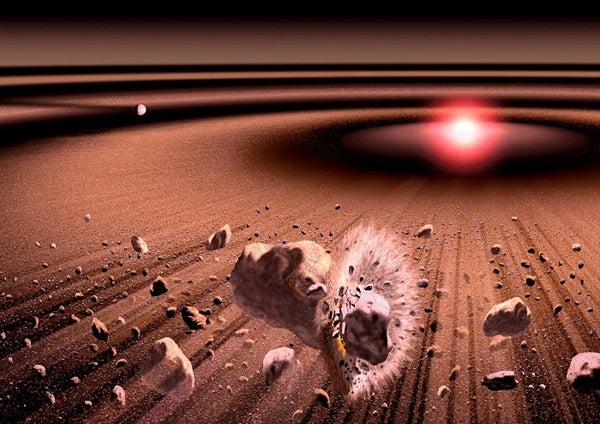A team of Japanese astronomers led by Yoshiko Okamoto of Japan’s Kitasato University has announced the discovery of a ring of silicate dust orbiting a nearby star, Beta (β) Pictoris. The new ring joins two others previously identified, and its placement suggests a planet orbiting within the system. The researchers also have examined the dust’s mineral content and found evidence for a growing planetary system still in its early stages.
Dust doesn’t linger around a star. The pressure of starlight quickly blows it out of the system — or, for larger particles, causes them to spiral into the star. Therefore, dust’s presence means particles are being replenished continually. The most likely source, say the astronomers, is the bump-and-grind of collisions among planetesimals orbiting the star in asteroid belts at distinct distances.
Beta Pic lies 63 light-years away and has an age estimated at 12 to 20 million years. Astronomers discovered in 1983 that the star has a disk of dust seen almost edge-on, but details have remained elusive. The new observations were made at mid-infrared wavelengths using a high-resolution spectrograph on the 8.2-meter Subaru Telescope atop Mauna Kea in Hawaii.
The spectra show peaks of thermal emission corresponding to room-temperature warmth. These indicate belts of planetesimals (asteroids) orbiting at distances of 6.4 astronomical units, 16 AU, and 30 AU. (Earth orbits the Sun at 1 AU.) The 16-AU belt also appears inclined slightly to the others. Astronomers had detected the 16 and 30 AU belts previously, but the 6.4 AU belt is entirely new. Moreover, the lack of dusty material between 6.4 AU and 16 AU suggests the presence of a planet orbiting at 12 AU from Beta Pic.
Astronomer Steve Desch of Arizona State University wrote a commentary that accompanies the paper, which appears in the October 7, 2004, issue of Nature. He told Astronomy the dust grains have a composition like basalt or lava. “They’re like rock everywhere,” he says, “and they’re like the rock Earth is made of.”
But the grains show signs of having been heated. “Interstellar silicate dust grains are nearly all amorphous, or glassy in structure,” he notes, adding that dust within a few AU of the star contains crystalline grains. These had to have been heated to 1,000 kelvins (1,800° Fahrenheit) or more, probably as they spiraled inward toward the star.
Says Desch, “All the grains we see in Beta Pic were liberated from larger bodies — comets or planetesimals — in the last few thousand years. This is a system that’s still in the process of creating terrestrial planets — we’re getting a unique snapshot of the conditions of planetary growth.”










